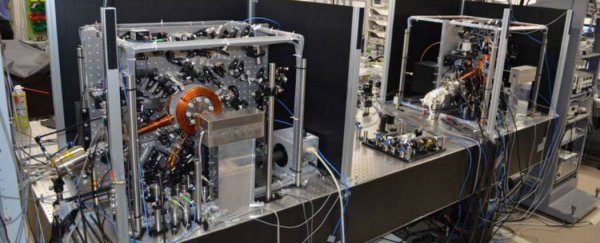Japanese researchers have developed a pair of time-keeping devices that are so accurate, they'll lose one second every 16 billion years, so, more than three times the age of the Earth, and 3 billion years older than the Universe itself.
Created by physicists led by Hidetoshi Katori from the Riken Research Institute, these 'cryogenic optical lattice clocks' are so accurate, they beat the caesium atomic clocks that are currently being used to define what a 'second' is. In fact, atomic clocks - which measure time based on how electrons in caesium atoms 'jump' at certain frequencies of radiation - tend to carry a one-second error every 30 million years.
According to Nicole Arce at Tech Times, the clocks work by using lasers to trap strontium atoms in grid-like, one-dimensional 'egg tray' structures, "which use what Katori calls the 'magic wavelength', so that the lattice does not affect the atoms during measurement", she says. The frequency of the strontium atom vibrations is then used as a measurement of the passing time.
To ensure that even the slightest increase in temperature or the movements of surrounding electromagnetic waves doesn't mess with the delicate measurements, the laser lattices have to be cooled to -180 degrees Celsius, and the inner copper surface is coated in black to suppress any tiny reflections of light.
After 11 measurements performed over a month, the team reports in Nature Photonics that they recorded a statistical agreement between the two cryoclocks of 2.0 × 10−18, which they equate to a one-second error every 16 billion years. "Through improved precision, we hold high hopes for accelerated discussions on redefinition of the 'second'," they said in a press release.
What do these new clocks mean for us regular folks? Right now, our power grids, GPS technologies, and the clocks on our computers and smartphones are all synced up to how caesium atomic clocks are keeping time. While the clocks on our computers being a mere fraction of a second out over millions of years isn't exactly going to affect our lives, that tiny discrepancy can make things difficult when trying to pinpoint an exact location via GPS, and it can affect how accurate our measurements are when it comes to things like predicting earthquakes, says Nicole Arce at Tech Times.
"If we can miniaturise the technology even further, it would have useful applications since tiny fluctuations in gravitational potential could be used to detect underground resources, underground spaces, and the movement of lava," Katori told her.
Source: Tech Times
